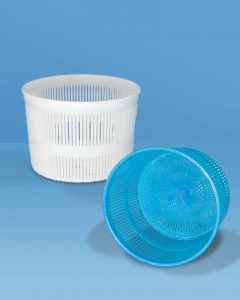Limburger is a washed rind cheese with a pale yellow color and an orange rind. At one month maturation, this delectable cheese sports a firm, crumbly and salty taste just like Feta. As it ripens to six weeks, Limburger softens at the corner, but the center remains firm, chalky and salty. At two months, this cheese becomes smooth and creamy. At a longer maturity period of three months, it develops intense smell and flavor. Known to be one of the stinky cheeses, Limburger is not a recipe cheese, but you’ll be surprised how mild its taste is compared to its smell. Limburger makes a great snacking cheese and an ingredient to onion soup and meat dishes. Limburger is worthwhile to make, Here’s a recipe.
Yield: approximately 900g Limburger cheese
Aging: less than 3 months
INGREDIENTS
1. 7.5 L milk (not ultra-pasteurized)
2. 1/ 4 teaspoon MM100 Mesophilic Culture
3. 1/32 teaspoon Danisco Geo 17
4. 1/32 teaspoon Danisco PLA YLO 10 (Brevibacterium Linens) + 1/64 teaspoon for the washing phase
5. ½ teaspoon Calcium Chloride (dilute in ¼ cup non chlorinated water)
6. ½ tsp Single Strength Liquid Rennet diluted in¼ cup filtered water
7. Salt
Equipment
1. large stainless steel pot
2. thermometer
3. curd knife and curd cutter
4. slotted ladle or spoon
5. cheese hoops
6. draining mat
7. cheese cloth or butter muslin
8. colander
INSTRUCTIONS
Reminder: Sanitize all your equipment before you start making cheese.
1. Pour the milk to a large pot and heat to 320.
2. Sprinkle the MM100 mesophilic culture, the Geo 17 and 1/32 teaspoon of the bevibacterium linens (LYO 10) on the surface of the milk.
3. Allow these cultures to rehydrate for 2 minutes.
4. Stir in an up and down stroke for a minute to thoroughly mix the culture with the milk.
5. Add the calcium chloride. Stir well.
6. Cover the pot and let the milk rest for 30 minutes. This is to allow the culture to ripen.
7. Add the rennet. Stir in an up and down motion for 1 minute.
8. Cover the pot and wrap in a towel. Let it rest for 6o minutes or until you get a clean break.
9. Cut the curds into 5/8 inch cubes. Let it rest for 5 minutes to allow the curd to heal.
10. Gently stir for 5 minutes.
11. Gradually increase the temperature to 920 C over a period of 15 minutes. Continue to stir gently to prevent the curds from matting.
12. Once you reach the target temperature, continue to stir the curds for 15 minutes.
13. Check the curd for firmness. Hold a small amount in your hand and put a little pressure with your thumb. It should barely stick together.
14. Let the curds set for a few minutes to allow the curds to settle under the whey.
15. Line the colander with cheese cloth or butter muslin.
16. Pour the curds into the cloth lined colander and allow it to drain for 30 minutes.
17. Transfer the curds into the cheese hoop and allow to drain some more for 8 hours. Put a draining mat on top of the cheese hoop and turn the cheese over every 2 hours.
18. Remove the cheese from the mold. Rub some salt all over its surface.
19. Place the cheese in a ripening box with a draining mat inside. Put a damp paper towel in the box, but make sure it does not touch the cheese. This is essential to maintain the moisture.
20. Ripen the limburger at 140 C to 160 C, turning the cheese daily over the next 3 to 4 days. Change the mat when it gets too damp and wipe away any excess moisture. Replace also the damp paper with a new one.
21. After a week, wash (do not soak) the cheese with a simple brine solution (1 cup of water and 2 teaspoons of salt). Also turn the cheese over daily. Do this daily for 10 to 12 days.
22. Wrap the cheese in parchment paper, then foil. Place it in a sealed aging box and age for 1 to 3 months at 40 C to 100 C. You can replace the parchment paper as necessary. It can also be misted lightly with filtered water to keep the Limburger moist during aging.
Recommended Cheese Hoops for Limburger Cheese
Round Hoop with base 160 x 145 Height

Round Hoop with base 130 x 110 Height

Round Hoop with base 140 x 90 Height

Square Hoop with base 122(L)X122(W)X160(H)

Try Also These Cheese Recipes
Are you Planning to Start a Cheese Making Business?
Cheese Kettle also offers brewing and dairy consultancy services. If you are planning to upscale your cheese making hobby and turn it into a business, we can help you with your planning. We have a highly rated comprehensive starter report that can help you start your business. We also offer hourly consultancy services and provide and customize high quality dairy processing equipment. Contact us today!






